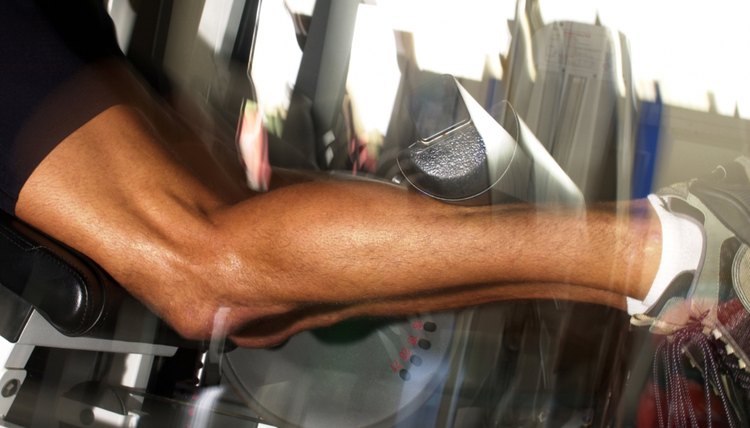Examples of Isotonic & Isometric Exercises

Though both isotonic and isometric exercises strengthen muscles, these two forms of exercise differ in fundamental ways. Isotonic exercises involve moving your joints and muscles rhythmically and repetitively through their ranges of motion using low resistance, while isometric exercises are static and require you to contract your muscles without joint motion.
Sports
Most sports can be characterized as forms of isotonic exercise. Cycling, swimming, basketball and racket sports all put your joints through various ranges of motion using gentle to moderate stress. Likewise, activities of daily living, such as walking, climbing stairs and gardening, involve isotonic movements including stretching, reaching or bending. This type of movement is less prevalent in modern life, since time and effort-saving machines have replaced many manual labor tasks. Isotonic exercise has a cumulative effect, so it's possible to fulfill your daily exercise needs with small bursts of activity sprinkled throughout the day, according to Harvard Health Publications.
Leg Extension
If knee arthritis limits your ability to participate in sports or other isotonic activities, try a leg extension. The Arthritis Foundation recommends this safe and effective isotonic exercise for the quadriceps. This exercise strengthens the muscles around your knee without causing impact to the knee joint. Perform this exercise in a seated position in a straight-backed chair. Starting with your hips and knees bent to 90 degrees and your feet hip-width apart, raise one foot slightly above the floor and slowly straighten your leg. Hold your leg in the straightened position for six to 10 seconds. Slowly bend your knee and return to the starting position. Repeat on the opposite side.
Shoulder Rehabilitation
You can strengthen and rehabilitate an injured shoulder without putting the joint through excessive movement using isometric exercises. Ohio State University’s Wexner Medical Center recommends a series of isometric exercises that you can do using just your body or with a wall. To strengthen the front of your shoulder, make a fist with one hand and place it in the palm of the other hand. Holding your arms in front of your chest, press your fist into your palm while resisting with your palm. Hold for a few seconds then relax and repeat. For the back of your shoulder, stand with your back towards a wall. Place a pillow between the wall and your elbow. Press your arm backwards into the wall. Hold for a few seconds then relax and repeat.
Knee and Hip
To strengthen you knee with isometrics, sit on the floor or a table with your leg stretched in front of you. Squeeze your thigh muscle to fully straighten your leg while flexing your ankle and lifting your toes up. Hold the contraction for five seconds, then rest for three seconds. Repeat up to 50 times. Perform an isometric exercise for the hips in a seated position with a pillow, towel or small ball between your knees. Squeeze your knees together and hold for 10 seconds.
References
- Arthritis Foundation: Strengthening Exercises
- Harvard Health Publications: How Much Exercise Do You Need? From Harvard Men's Health Watch
- Ohio State University Wexner Medical Center: Isometric Shoulder Exercises
- University of West Alabama Athletic Training & Sports Medicine Center: Knee and Leg Exercise Pogram
Writer Bio
This article was written by the CareerTrend team, copy edited and fact checked through a multi-point auditing system, in efforts to ensure our readers only receive the best information. To submit your questions or ideas, or to simply learn more about CareerTrend, contact us [here](http://careertrend.com/about-us).
